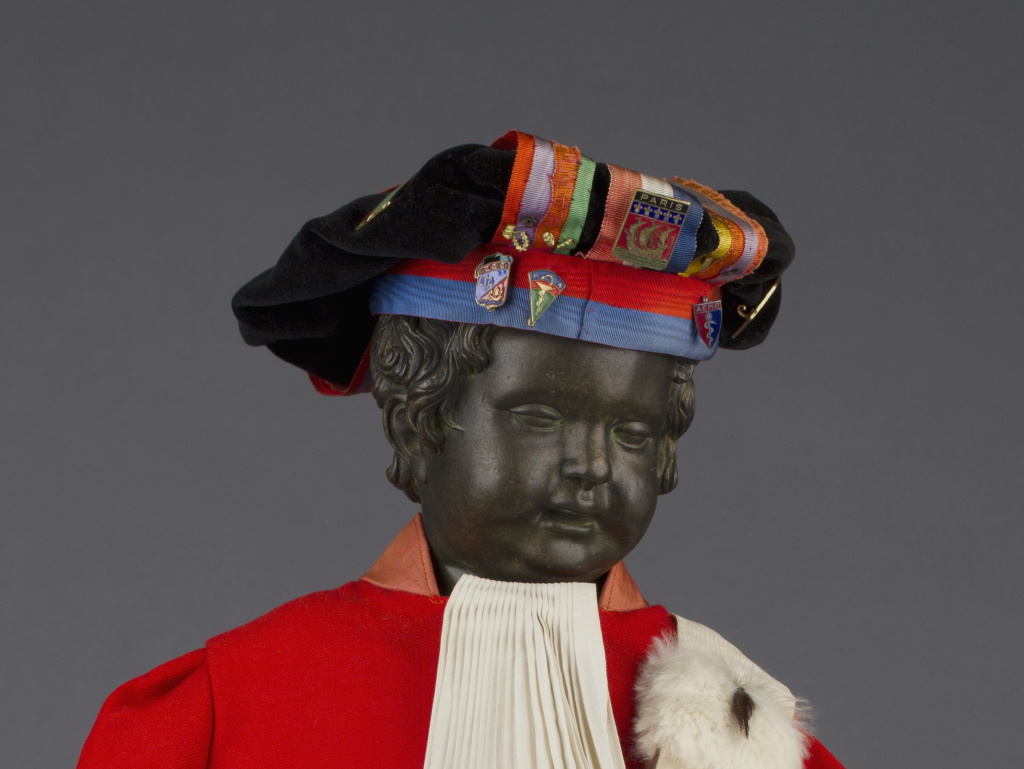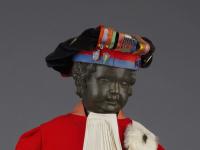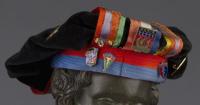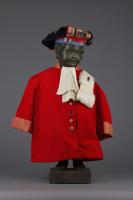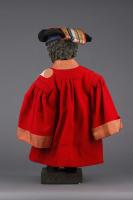Manneken-Pis is one of Brussel's folk symbols (studentical or not). The statue, which answers to the sweet name of "The little man that’s pissing", is clothed by its visitors since for more than 300 years and today he possesses around 1000 folk costumes which he proudly wears during the different event of the city.
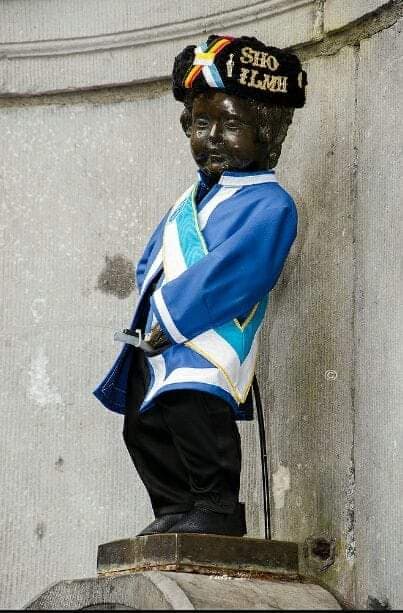 To help us understand, Imane, baptised in Brussel, explains why her order offered him one : "We offered him a calotte, a band and a gown to celebrate the 40th birthday of the Order of Saint Jerome. They have been made special for the event. You have to know that when somebody does so, the costume is offered to Manneken Pis, and is then exhibited at the museum for 1 week, finally it is carefully stored in a drawer. As an association from Brussels, it means a lot to us to show that we are integrated in the local folklore. Manneken Pis already wore numerous costumes and it was obvious for us to do the same, since many circles and orders do so. It is also a reason to feast and to put a beer keg into the fountain that runs through Manneken-Pis."
To help us understand, Imane, baptised in Brussel, explains why her order offered him one : "We offered him a calotte, a band and a gown to celebrate the 40th birthday of the Order of Saint Jerome. They have been made special for the event. You have to know that when somebody does so, the costume is offered to Manneken Pis, and is then exhibited at the museum for 1 week, finally it is carefully stored in a drawer. As an association from Brussels, it means a lot to us to show that we are integrated in the local folklore. Manneken Pis already wore numerous costumes and it was obvious for us to do the same, since many circles and orders do so. It is also a reason to feast and to put a beer keg into the fountain that runs through Manneken-Pis."
Some of his costumes are regularly brought out. November 20th, for example, he gets dressed for the traditional student feast Saint Verhaegen, during which he showers the passers-by with Brussels beer which comes from his majestic dick.
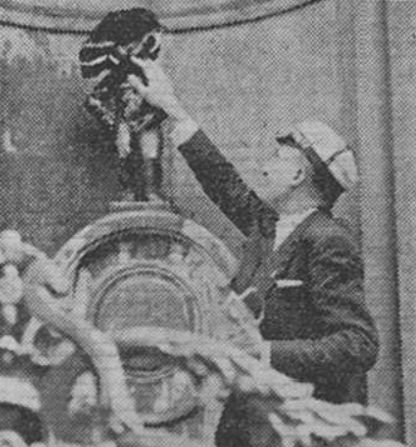 During the 1939 Easter holidays, even when Europe was about to be pulled into the world war, UNEF (National Student Union of France) began its traditional annual convention, the 28th. After the Minister of Education’s speech, during which he promised that the students wouldn’t be called to arms, they ended their first day of the convention and were invited by the Belgian students to visit their country. This same evening, at 1 am, several coaches took half of them (around 150) to Mechelen, Antwerp and above all Brussels. Before being officially welcomed at the town hall, they put flowers on the Poilu Inconnu’s (Unknown Solidier's) grave and went to the Etuve Street to visit Brussel's oldest citizen.
During the 1939 Easter holidays, even when Europe was about to be pulled into the world war, UNEF (National Student Union of France) began its traditional annual convention, the 28th. After the Minister of Education’s speech, during which he promised that the students wouldn’t be called to arms, they ended their first day of the convention and were invited by the Belgian students to visit their country. This same evening, at 1 am, several coaches took half of them (around 150) to Mechelen, Antwerp and above all Brussels. Before being officially welcomed at the town hall, they put flowers on the Poilu Inconnu’s (Unknown Solidier's) grave and went to the Etuve Street to visit Brussel's oldest citizen.
Claude Delorme, President of the UNEF since 1936, put a magnificent Honorary Flatte on Manneken Pis. "By making him an honorary member of the National Student Union of France, we want to make our gesture a symbol of the immortal friendship between France and Belgium" he proclaimed.
They ended their day in Belgium with a traditional sausage carnival. The next morning, Belgian and French students went to the Valenciennes town hall before heading back to Versailles, where the convention was held. A few weeks later, Europe burst.
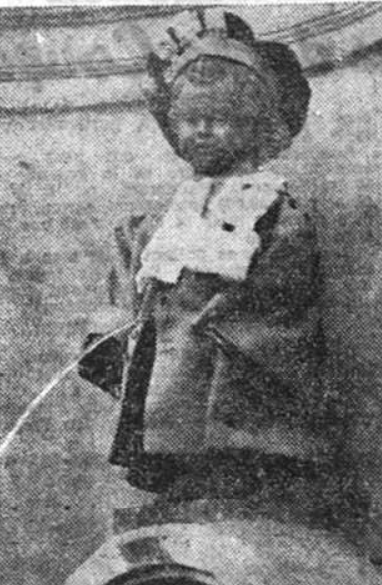 But the war didn't affect the good relationships between the French and the Belgian students at all. Less than a year after the capitulation of Germany, Robert Catteau, the Education Manager of the city, who represented Brussel's mayor, celebrated the return of French and Belgian student traditions. Indeed, March 13th 1946, after they were welcomed by the president of the U.L.B. Student Association, a delegation of student from Lille gave another Honorary Flatte to the famous "Little Julien" as well as a student gown. "We usually don’t associate ourselves with citizens, but we gladly make an exception for Manneken Pis, the oldest citizen from Brussels" announced the French representative.
But the war didn't affect the good relationships between the French and the Belgian students at all. Less than a year after the capitulation of Germany, Robert Catteau, the Education Manager of the city, who represented Brussel's mayor, celebrated the return of French and Belgian student traditions. Indeed, March 13th 1946, after they were welcomed by the president of the U.L.B. Student Association, a delegation of student from Lille gave another Honorary Flatte to the famous "Little Julien" as well as a student gown. "We usually don’t associate ourselves with citizens, but we gladly make an exception for Manneken Pis, the oldest citizen from Brussels" announced the French representative.
Manneken Pis's costumes are preserved by the Order of Friends of Manneken-Pis. It seems that, sadly, the flatte from 1946 was lost. The flatte from 1939 and the gown from 1946 can be seen at the Brussels museum of Manneken Pis's Wardrobe.
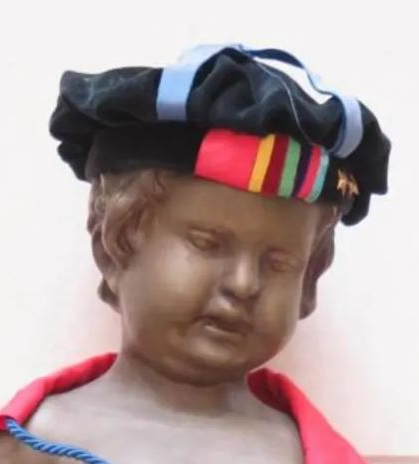 It is impossible to end this article without talking about the Manneken Pis at the Police Station in Poitiers. (Traditionally known as Bitardbourg during the Studentical Week). Given in 1950 to the Poitier Police by the Brussels one, this copy, which is the only one allowed to be dressed, regularly dons the colors of the Ordre du Vénéré Bitard (Praise Him) with which he wears the Flatte.
It is impossible to end this article without talking about the Manneken Pis at the Police Station in Poitiers. (Traditionally known as Bitardbourg during the Studentical Week). Given in 1950 to the Poitier Police by the Brussels one, this copy, which is the only one allowed to be dressed, regularly dons the colors of the Ordre du Vénéré Bitard (Praise Him) with which he wears the Flatte.
Below you can see some photos of the Flatte from 1939, and Manneken-Pis wearing it with the 1946 gown. Copyright Musée de la Ville de Bruxelles - GardeRobe MannekenPis
Thanks to the Manneken Pis Wardrobe Conservator for his help, and to La Mite from Academia Studentica and L'Ostreiculteur from the French Archivistes for their read-thought.
Sources : Newspapers L'Excelsior (12/04/1939), La Dernière Heure (13/04/1939), Le Journal (13/04/1939), Le Soir (13/04/1939 et 10/06/1947), La Meuse (20/04/1939), La Dernière Heure (14/03/1946), Centre Presse (04/01/2016) and Faluche.info



